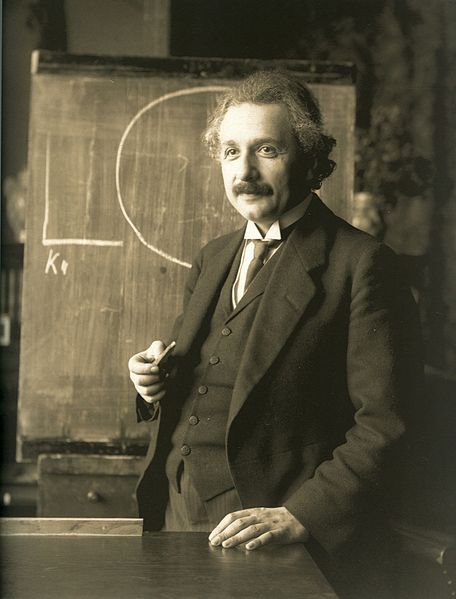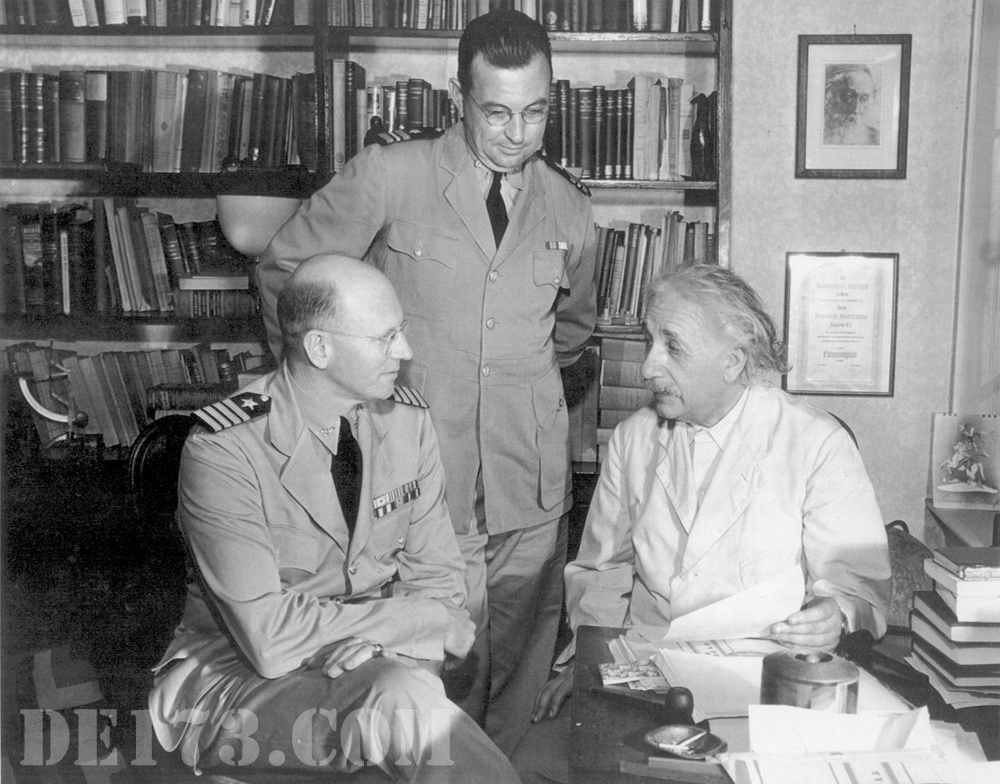
Did The PX Involve Einstein’s Unified Field Theory?
Carl Allen claimed in his letters to Morris Jessup that the Philadelphia Experiment was based on a Unified Field theory that Einstein had published in the mid-1920’s but later “withdrew as incomplete.” Einstein’s friend and world-renowned philosopher, Bertrand Russell, is said by Allen to have privately asserted that Einstein’s theory was indeed complete, but that Einstein had come to the conviction that the world would not be ready for it “until after WW3.” Nevertheless, Allen writes, the theory was checked out by Naval Scientists including one “Dr. Franklin Reno” (evidently a pseudonym), and the results were positive enough to lead the Navy to design and install massive electromagnetic generators and other equipment on a ship in an effort to apply this “withdrawn” unified field theory to a big hunk of iron with a lot of men on it.
Carl also states that he personally met and seen Einstein on the Eldridge;
“Dr. Albert Einstein called on me to ask: “What did you see, feel, and think?” Because I was, and still am, the only living person who observed, at very close range, the DE-173 in the act of becoming invisible, and who plunged his arm, halfway to the elbow, into that stupendously colossal, whirling-whizzing forcefield and lived to tell about it.”

Albert Einstein 1879 ~ 1955
In August of 1986 Carl did a interview with the “THE NEWS of Colorado Centennial Country” newspaper; Carlos Allende “death bed statement” where he restated Einsteins involvement below;
“Einstein was on the test ship the DE168. I was on the U.S.S. Feurseth.”
“Einstein and his team were using the Navy for their research. Steinmetz wound the coils on the beam generator. It was based on the work of Tesla”
“What Einstein proved was that invisibility is a precursor to propulsion beyond the speed of light. Invisibility is nothing more than the precondition to a practical utilization of the magnetic field related to the Einstein Tunnel Propulsion system.”
“Einstein came to me, and trained me in the theory of invisibility. He said they were using the Navy for his own research..” – Carl Allen
Carl has stated this in many interviews one of the few times you can find it in Carl’s own handwriting appears in “HOAX: The Philadelphia Experiment Unraveled”, Pg 238;

Was Einstein Employed By The Navy?
On May 31st, 1943 Albert Einstein signed a consultant’s contract with the R&D Division of the U.S. Navy. This was later extended until June 30th, 1944. I was able to locate his time cards in The National Civilian Personnel Records Center. Below are his Official Navy Time cards, showing he was working with the Navy during the time frame Carl Allen states he witnessed Einstein working on the project.
The Unified Field Theory
If the Experiment did embody Einstein’s theories, we must ask, in light of Allen’s stories of an apparent “teleportation” of ship and crew, why does nobody mention any great gravitational disturbance associated with the ship’s disappearance and reappearance? Was this really an application of Einstein’s Unified Field Theory?
Or was it perhaps just an early radar experiment related to electronically jamming or shielding incoming enemy radar pulses so that they would not be reflected back to their source radar receivers, thus making the shielded ship “invisible” to enemy radar?
Is it possible that the power levels used were too high and that some of the crew were inadvertently “microwaved?”
Next we will look at Einstein’s Unified Field Theory in more detail, what was it? why would we want to unify fields?
Albert Einstein, the patent-clerk-turned-physicist who revolutionized the science of the 20th century with his Relativity theories, spent many of his later years trying to unify electromagnetism and gravity.
The ‘Authorized Version’ of the story says that Einstein never achieved his lofty goal. Carl Allen claims that he did succeed, but later “withdrew” his Unified Theory because the world was not yet ready for it. In 2015 James E. Beichler published a paper called “The Einstein unified field theory completed.” A direct challenge to the basic assumptions, theories and direction of modern and post-modern physics.
To explore Einstein’s Unified Field Theory first we need to understand what we mean by the ‘unification of fields’, and why do we want to unify them?
First Of All, What’S A ‘Field?

Let’s use a simple magnet to illustrate what we mean by a “field.” Hold a magnet in one hand, and a nail in the other. Notice that, as you bring the nail and magnet closer together, the two begin to “pull” at one another. If you bring them close enough, they’ll try to jump right out of your fingers in an effort to stick together. This is simple magnetic attraction on iron objects.
Next, bring a second magnet near the first. Depending on how the two are oriented, you will either feel an attraction between them, as with the the nail, or else you will feel a pushing apart, a repulsion. Each magnet has two opposite poles, a “north” pole and a “south” pole. Opposite poles attract one another; like poles repel. So, when your two magnets were trying to push one another apart, it was because you were facing either two north or two south poles at each other.
Either way, whether your magnets were pushing or pulling at each other, you did not have to have them actually touching in order to feel the influence between them; there seems to be a continuous field of influence that extends out from each magnet into the space around it.
Scientists like to picture this field as consisting of invisible lines of force surrounding each magnet, entering and exiting (and concentrating in intensity) at the north and south poles. Even though we can’t see anything in the space around the magnets, we can feel an effect and thus indirectly measure the “field.” We note that the strength of the attractive or repulsive field weakens as we separate the magnets; if we were to plot the field strength on a graph, we would come up with an exponential decay curve, where the field becomes
very small as we go out a relatively short distance from the magnets. We might conclude that eventually the field will reduce to zero, but an exponential field just gets smaller by smaller increments, and so never really reaches zero; thus there is always some tiny interaction between the magnets.
Now, put the magnets down and jump up into the air. Do you launch yourself into outer space by doing this? No, you get pulled back to earth by a force that attracts, not just iron or magnets, but all masses, including you: the gravitational force. It, too, pulls more weakly on you if you can manage to get far enough away from the earth; but the earth’s gravity still tries to reel you back in, no matter how far out you go.
Could there be an underlying “force” that manifests itself as “magnetism” here and “gravity” there? And also a third force, the electrical force– is it also a part of this underlying “force?” Is the reason they are similar because they are different facets of the same thing? Can we prove, mathematically as well as experimentally, that these three fundamental forces are unifiable into one?
Why Do We Want To ‘Unify’ Force Fields?
The answer is very simple: We’re not trying to “unify” them per se; we’re trying to prove that they already are unified; we want to understand what gravity is and to be able to control it to the degree that we now understand what electricity and magnetism are, and are able to control them for our own uses.
What we’re hoping is that, if gravity, electricity and magnetism are different forms of the same thing, then maybe we can build some device using one or both of the ones we have experience with (electricity and magnetism,) to generate the third (gravity.)
20th century technology is what it is today because of the efforts of men like Ampere, Faraday, Maxwell and Hertz. These 19th century scientists and mathematicians pioneered the theoretical and early experimental work in electricity and magnetism which we take for granted today. Science hopes for a time when the basics of gravitation will be understood well enough to give birth to a technology: antigravity generators and propulsion systems. (And, yes, pure theorists are hoping to get their jollies just by proving that all of nature’s forces can be reduced to One.)
But if Albert Einstein’s Relativity Theory is correct, he who holds the key to gravity also holds the key to time itself, since one affects the other. The implications are both awesome and ominous. This used to be God’s territory alone. Now it looks as if Man (and most likely the military, no less!) may be on the brink of discovering “Reality Engineering”; we can only assume we were “meant” to figure it out, sooner or later. The responsibilities that come with this make even the darker side of Genetic Engineering look like a Sunday picnic.
Most people today balk at fundamentalist Christians and their “Creation Science.” To understand the “mysteries” of gravity and time, and to be able to engineer them and develop a technology based on them, would infuse an entirely new meaning to the phrase “Creation Science:” It would become synonymous with the Engineering of Reality itself!
But hold on a second– Isn’t gravity a force totally separate from either electricity or magnetism?
As it turns out, there are enough similarities between the gravitational force and the electromagnetic to provide the basis for a long-held hope by many physicists that one day they might discover the unifying relationship between the two. The mathematical and experimental search for such a unifying “key” has been going on for the better part of a century now; what Einstein was searching for continues to gnaw at physicists.
Similarities, Dissimilarities
What are some of the similarities between gravity and electromagnetism? Well, one is that the intensities of both types of field vary inversely as the square of the distance from an object emitting the field. This property alone led scientists to suggest that the two types of force might be simply two different sides of the same coin. Perhaps gravity and electromagnetism could be unified in the same way that Maxwell had unified electricity and magnetism, leading to the postulation and then confirmation of an electromagnetic force.
But as time went on, the differences between gravity and electromagnetism became more apparent: for example, electrically charged particles will attract or repel each other, depending on the respective polarity of each particle. Just as in our two-magnet example above, two positively-charged particles repel when brought close together, as do two negatively-charged particles. An opposite charge on either particle, however, such as one positive and one negative, will attract one another; the same happens when opposite magnetic poles are brought near one another.
So both electric and magnetic “force fields” are bipolar. Because an equal amount of negative and positive charge algebraically sums to zero, we can completely “cancel” the electric or magnetic field in an area, even though each of them, separately, extends out to infinity via its exponential curve.
Gravity, as far as we can tell, is uni- or mono-polar; gravity attracts only (if we could reverse the flow of time, of course, we would expect to observe a repulsion between two gravitating masses; a time-reversed attraction becomes a repulsion.) Thus all masses in the universe attract each other, however weakly.
Another difference between gravity and electromagnetism, apparently, is the speed of propagation: Electrical charges affect each other at the speed of light; gravity seems to be instan-taneous (at least according to Newton’s conceptions.)
What are these fields that are so similar in some ways, yet so different in others? Are they only different forms or manifestations of the same thing, such as is the case with matter and energy?
What Is Einstein’S Relativity Theory All About?
To put it as simply and briefly as possible, Einstein published two Relativity theories: Special Relativity and General Relativity. Both were radically new ways of looking at the universe and its forces, quite different from the currently accepted Newtonian theory.
Special Relativity says that there is no absolute reference point by which we can measure absolute movement of an object through space, since everything is in motion. Like being on a train and passing another one (or is the other one passing us?), we can measure relative motion by establishing a reference point, but never absolute motion.
Stranger still, this ties in with Time: it too is relative, and may only be measured with reference to something else; there is no Absolute Time, and “Now” is relative. Accordingly, space and time (or our perception of passing through them) may be distorted by our motion through space. If we travel very fast (say, near the speed of light), time appears to slow down and space begins to contract.
Equally bizarre is Einstein’s General Relativity theory: Isaac Newton systematized his observations of gravity and the laws of motion in the 17th century. Apples fall down to the ground, and planets orbit the Sun (balanced between falling into the Sun and flying off at a tangent due to Centrifugal Force,) because the massive bodies pull on other masses via an invisible force that we call Gravity.
Gravity appears to be a property that all masses posess. Apples fall down because the earth is much bigger than any apple, and its gravity overcomes the apple’s own tiny gravity force. If the apple and earth were the same size, they’d fall into each other.
Einstein came up with a whole new way of looking at it: Things don’t fall because of some mysterious force that things have in them to pull other things toward them; things fall because the space around a massive object is bent or distorted.
Time is intricately related to space, and time is also distorted near a massive object. Einstein and his proteges referred to the two entities, space and time, not as separate things, but as two interrelated facets of a “higher” entity which they called spacetime. In fact, what we’re talking about is a higher dimensional geometry– our normal 3- dimensions plus Time as a 4th– and the paths of falling objects are therefore nothing more than geodesics (straight-line paths) in 4-space.
If you’re confused, take heart: most of the scientific world was just as bewildered for many years before Einstein’s ideas were generally accepted. Even today there are a few “diehards” who don’t swallow Relativity theory; we are assured, however, that several experiments have been done over the years that prove Einstein right in his counter-intuitive views. There are many good books for the beginner that explain Relativity far better than I have here.
Now one of the many interesting things that emerged from Einstein’s theories is that matter and energy are equivalent: they’re different forms of the same thing, which led to the invention of the Atomic Bomb. The Bomb used small amounts of radioactive matter and converted it into large amounts of radiant energy– electromagnetic waves in the form of a nasty amount of heat, light, x-rays and gamma radiation. Evidently Einstein was right on the mark with this one.
In principle, you ought to be able to do the reverse: Somehow gather lots of energy (which is what heat and light waves are), concentrate it or “trap” it, and it should solidify or “materialize” into matter again. Maybe you could do it slowly, over time, to avoid unpleasant side-effects such as experienced over Hiroshima and Nagasaki in 1945. Nonetheless, matter would eventually come to be, out of “nothing,” and with it an accompanying gravity field.
Thus, the implication is that the energy of waves (light, heat, and other forms of electro-magnetic waves) can be converted into mass, and vice versa. Thus, mass and energy are different forms of the same underlying “thing.” By extension, the electromagnetic forces ought to be related to the gravitational forces associated with mass. E=mc2, Einstein’s famous equation, means that a given amount of energy is equivalent to a given amount of mass times the square of the speed of light. The all-important role of the speed of light in Einstein’s theories, as the limiting speed of all masses, is a direct extension of Pythagorean geometry. The ancient Greeks probably would have loved 20th century spacetime theory, at least inasmuch as it is actually a form of spherical geometry at its heart.
So What Did Einstein Come Up With?
Well, to oversimplify in the extreme, Albert Einstein did a lot of abstract, complex math in connection with his Relativity theories and basically ended up with sixteen “Tensor” equations that expressed the relationships between electric, magnetic, and gravitational fields. One thing that came out of this, as related by Berlitz and Moore, is that;
“a pure gravitational field can exist without an electromagnetic field, but a pure electromagnetic field cannot exist without an accompanying gravitational field.”
How strong an electromagnetic field do we need to generate, and in what configuration, in order to ‘feel the effects’ of its accompanying gravitational field?…
Einstein kept trying to solve his elusive unified field theory through the very last hours of his life. At his bedside in the hospital was a notebook containing 12 pages of calculations that Einstein hoped could bring the world one step closer to understanding the universe.
“When a man sits with a pretty girl for an hour, it seems like a minute. But let him sit on a hot stove for a minute — and it’s longer than any hour. That’s relativity.” – Einstein
“One thing I have learned in a long life: That all our science, measured against reality, is primitive and childlike — and yet it is the most precious thing we have.” – Einstein
“As far as the laws of mathematics refer to reality, they are not certain; and as far as they are certain, they do not refer to reality.” – Einstein
“Though his own work never produced a useful physical theory, Einstein established unification as an important goal of physics. Indeed a theory of everything is commonly called the “holy grail” of modern physics. Einstein would probably be pleased that so many physicists are enthusiastically devoting their careers to pursuing his dream.” – American Physical Society






